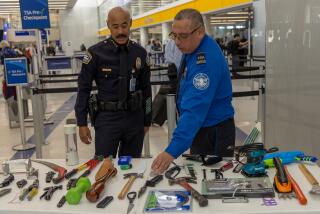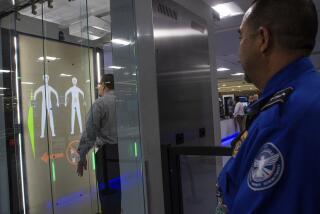Before takeoff, LAX scanner takes it all off
Some travelers at Los Angeles International Airport will be searched for weapons and explosives using a new scanner that peers through their clothes and creates an image of the person’s body, federal officials announced Thursday.
The sophisticated technology, called millimeter wave imaging, may prove to be a more effective way to check travelers for guns, knives, bombs and other dangerous materials than pat-down searches. But it has raised questions by privacy and civil rights advocates, who say the screening process is extraordinarily invasive and amounts to a virtual strip search.
“I don’t think people are really aware of just how accurate and detailed the images are of their naked body,” said Peter Bibring, a staff attorney for the American Civil Liberties Union office in Los Angeles. “We need to make sure there are good safeguards. The temptation is great not to follow procedures when a celebrity or someone well-known is involved.”
Millimeter wave pictures are white and dark gray. Though somewhat fuzzy, they are detailed enough to reveal bulges in the body, such as the shape of a breast or muscle. The machine uses radio waves to create an image from energy reflected from the human body.
This results in a 3-D image that essentially shows how the person looks without clothing. It also shows hidden objects such as guns and explosives.
Officials with the federal Transportation Security Administration said that this year the agency planned to buy at least 30 more scanning devices, at about $150,000 each, for use at other airports.
The TSA unveiled its “whole body imaging” machine Thursday at LAX. The device, which is part of a pilot program involving major airports, is being tested at a TSA checkpoint for passengers departing on Delta Airlines in Terminal 5.
“This will allow us to enhance our security at LAX,” said Nico Melendez, a TSA spokesman. “Imaging devices are not a brand-new security tool, but they are a brand-new security tool for airports.”
Travelers randomly selected for secondary screening have the choice of going through the scanning device or being subjected to other screening measures, including pat-down searches. Signs in the checkpoint area will advise them of the option.
During the process, a person walks into a large portal -- about 9 feet high and 6 feet wide -- and assumes two positions for the scan. Security officers view the images in a booth about 65 feet away and are unable to see the passenger in question. To protect privacy, the faces of those scanned are blurred, and the images cannot be stored, copied or printed, federal officials said.
For some travelers, those privacy protections are not enough.
“Honestly, it’s embarrassing and extremely violating,” said Grace Kim, 28, of Los Angeles as she waited for the FlyAway bus to take her from Union Station to LAX on Thursday.
Kim said her concerns might partly be allayed if only a woman were to view the images, and if the screening occurred in a private room where the public couldn’t peek. But even with those concessions, “I’m still not completely thrilled about it,” she said.
Other travelers agreed.
“Oh, boy. I just think it’s an invasion to your privacy,” said Sandra Rodriguez, 42, of Valencia. “I don’t think it’s good. It’s just private.”
According to the TSA, about 80% of travelers scanned during recent tests at Sky Harbor International Airport in Phoenix opted for the imaging machine instead of a pat-down search. Melendez said there had been no complaints from passengers since testing began at Sky Harbor late last year.
Civil rights and privacy advocates say the resulting images are detailed depictions of the naked body -- images that should be tightly controlled to prevent them from being posted on the Internet, sold to tabloid publications or misused in other ways.
“It’s a high-tech strip search,” the ACLU’s Bibring said. “Blurred images of someone’s face can be undone by computer. The most important issue is no image retention. That is absolutely crucial for such an invasive technology to satisfy privacy concerns. We need to make sure it is implemented in a foolproof manner.”
Bibring also questioned whether scanners were a good use of the TSA’s resources, considering there is no indication that pat-down searches aren’t effective.
Melendez said the images in question are not as revealing or detailed as some critics have made them out to be. He said the complaints were based on old images from a different technology used in Phoenix early last year that produced more detailed pictures.
“First and foremost, we have done a lot of work with industry and other groups to address the issues related to whole-body images,” Melendez said.
“We would not have put the technology in place if we could not protect the privacy of passengers.”
TSA officials in Los Angeles said they would study the machine’s effectiveness, as well as privacy considerations, training requirements, safety issues and public perceptions. They added that there was no end date for the pilot project.
The machines are operating at airports in Britain, Spain, Japan, Australia, Mexico, Thailand and the Netherlands.
Calista Harcourt, 23, a tourist visiting L.A. from Australia, said she didn’t understand the fuss.
“I think it’s fine,” she said. “If they’re not going to distribute the images and they’re not storing it, and they’re just using it for security purposes, I think it’s OK.”
--
ron.lin@latimes.com
More to Read
Sign up for The Wild
We’ll help you find the best places to hike, bike and run, as well as the perfect silent spots for meditation and yoga.
You may occasionally receive promotional content from the Los Angeles Times.








